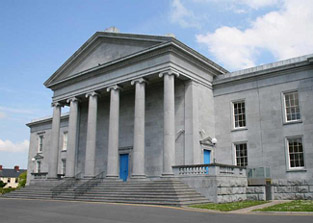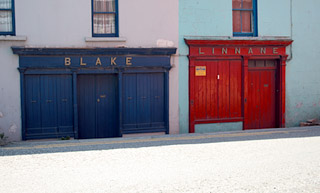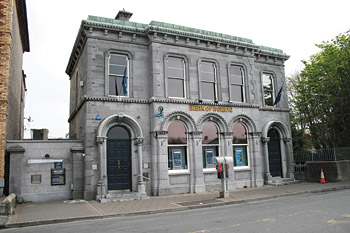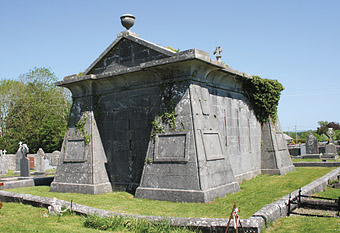Clare


 A new building type emerged in the late 18th century based on the design, by the architect James Gandon, for the courthouse in Nottingham, England. This was basically a five-bay building, sometimes of two storeys, with an entrance to each outside bay and internally a double-height courtroom. With minor variations, this plan was used for several of the county’s courthouses. Ennis courthouse is the major exception. The most impressive classical building in the county, it was completed in 1850. Architect John B Keane prepared a design in 1838, but the project did not proceed. A new competition was organised which was won by a young local architect, Henry Whitestone. Keane was also among the eighteen entrants. The winning design was apparently so close to Keane’s that both names are now associated with it.
A new building type emerged in the late 18th century based on the design, by the architect James Gandon, for the courthouse in Nottingham, England. This was basically a five-bay building, sometimes of two storeys, with an entrance to each outside bay and internally a double-height courtroom. With minor variations, this plan was used for several of the county’s courthouses. Ennis courthouse is the major exception. The most impressive classical building in the county, it was completed in 1850. Architect John B Keane prepared a design in 1838, but the project did not proceed. A new competition was organised which was won by a young local architect, Henry Whitestone. Keane was also among the eighteen entrants. The winning design was apparently so close to Keane’s that both names are now associated with it.
 Apart from the formal architectural statements of church, state and institutions, it is the so-called more ordinary building stock, with its variety of painted shopfronts, which gives the unique character to the streets of our towns and villages. With commercial use to the street and residential over it, many adapt the formal architectural details of grander structures including cornices, columns and pilasters. Crotty’s in Killaloe has adapted the type to allow for the steeply falling street. Although later in date than the other highlights, O’Connell’s Medical Hall in Ennis is a rare survival with its modernist design and detailing.
Apart from the formal architectural statements of church, state and institutions, it is the so-called more ordinary building stock, with its variety of painted shopfronts, which gives the unique character to the streets of our towns and villages. With commercial use to the street and residential over it, many adapt the formal architectural details of grander structures including cornices, columns and pilasters. Crotty’s in Killaloe has adapted the type to allow for the steeply falling street. Although later in date than the other highlights, O’Connell’s Medical Hall in Ennis is a rare survival with its modernist design and detailing.
 The growing prosperity in the mid 19th century lead to the development of a banking system with branches throughout the country. After churches, these local banks were often, architecturally, the most significant buildings in a town. Quality design was combined with good materials and fine craftsmanship. A new building type was developed incorporating a banking hall with a bank manager’s residence over it. Early designs reflect the influence of Italian palazzo design, the choice of style, no doubt reflecting the role of banking in Renaissance Italy. More eclectic designs emerged later, but still with a strong classical influence.
The growing prosperity in the mid 19th century lead to the development of a banking system with branches throughout the country. After churches, these local banks were often, architecturally, the most significant buildings in a town. Quality design was combined with good materials and fine craftsmanship. A new building type was developed incorporating a banking hall with a bank manager’s residence over it. Early designs reflect the influence of Italian palazzo design, the choice of style, no doubt reflecting the role of banking in Renaissance Italy. More eclectic designs emerged later, but still with a strong classical influence.
 The term mausoleum is derived from one of the seven wonders of the ancient world, the tomb of King Mausolos at Helicarnassos, now Bodrum in modern Turkey. Mausoleums are pieces of almost pure architecture, unencumbered by demanding clients or the functional requirements of most building projects. Other than housing of bodies, their sole function is to demonstrate their patron’s ongoing importance, even after death. A number of fine mausoleums are to be found in graveyards throughout the county with Egyptian, medieval and classical influences. The O’Loghlen mausoleum at Ruan has been described by historian Maurice Craig as ‘probably the finest example of the Egyptian style in the funerary line in all Ireland’.
The term mausoleum is derived from one of the seven wonders of the ancient world, the tomb of King Mausolos at Helicarnassos, now Bodrum in modern Turkey. Mausoleums are pieces of almost pure architecture, unencumbered by demanding clients or the functional requirements of most building projects. Other than housing of bodies, their sole function is to demonstrate their patron’s ongoing importance, even after death. A number of fine mausoleums are to be found in graveyards throughout the county with Egyptian, medieval and classical influences. The O’Loghlen mausoleum at Ruan has been described by historian Maurice Craig as ‘probably the finest example of the Egyptian style in the funerary line in all Ireland’.